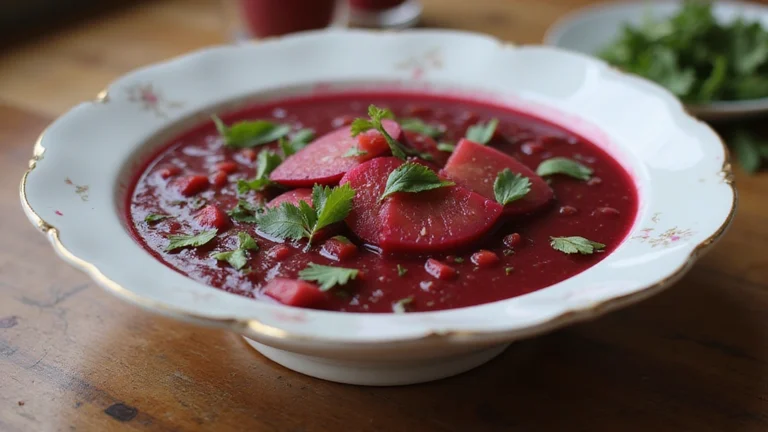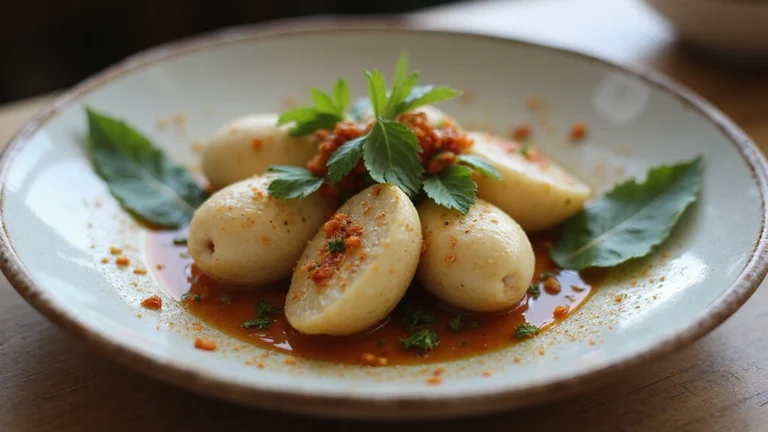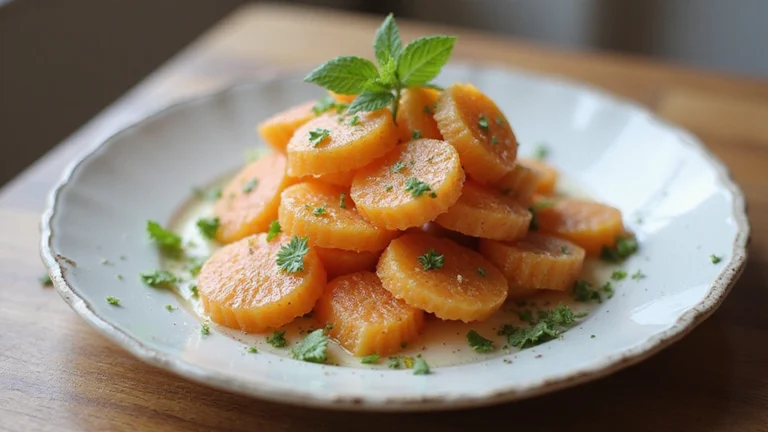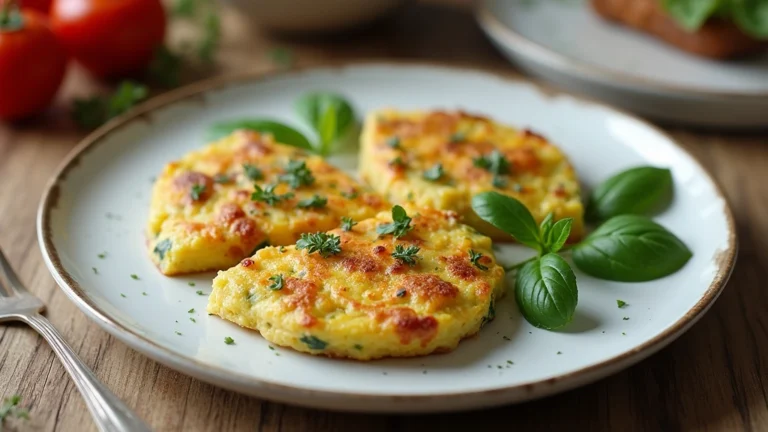
Are you craving Thai fried chicken that’s crispy on the outside and juicy on the inside? This authentic recipe brings the vibrant flavors of Thailand straight to your kitchen with minimal effort.
Crispy Thai fried chicken, known locally as “Gai Tod,” delivers a perfect balance of lemongrass, garlic, and traditional Thai spices that’ll transport your taste buds straight to the streets of Bangkok. Unlike standard fried chicken, this version incorporates distinctive aromatics that create an unforgettable flavor profile.
You’ll love how the chicken develops its signature golden crust while maintaining incredible tenderness inside. Whether you’re hosting a dinner party or looking for a family-friendly meal with international flair, this Thai fried chicken recipe is guaranteed to become a regular in your cooking rotation.
What Makes Thai Fried Chicken Special
Thai fried chicken (Gai Tod) stands apart from other fried chicken varieties through its distinctive flavor profile and preparation techniques. Unlike American or Korean versions you might be familiar with Thai fried chicken features a complex marinade infused with aromatic herbs and spices native to Southeast Asia.
The magic begins with lemongrass which imparts a subtle citrusy note that can’t be replicated with any substitute. Fresh garlic and coriander roots provide an earthy depth while fish sauce delivers that quintessential umami punch that defines Thai cuisine. These ingredients work together to create layers of flavor that penetrate deep into the meat.
Another distinguishing factor is the double-frying technique often employed in authentic preparations. This method ensures an exceptionally crispy exterior while maintaining juicy tenderness inside. The first fry cooks the chicken through while the second fry at a higher temperature creates that signature crackly crust Thai fried chicken is renowned for.
The coating differs significantly from Western-style fried chicken as well. Rather than a thick batter Thai fried chicken typically uses a lighter rice flour mixture that crisps beautifully without becoming heavy or greasy. This results in a delicate crunch that complements the aromatic meat perfectly.
Thai fried chicken also benefits from its accompanying condiments. Traditional servings pair the chicken with sweet chili sauce which balances the savory elements with just the right amount of sweetness and heat. Fresh herbs like Thai basil or cilantro often garnish the dish adding brightness to each bite.
Regional variations across Thailand add further nuance to this beloved dish. Northern Thai versions might incorporate more galangal and turmeric while southern preparations could feature additional heat from bird’s eye chilies. These regional differences reflect the diverse culinary industry within Thailand itself.
Ingredients You’ll Need for Thai Fried Chicken
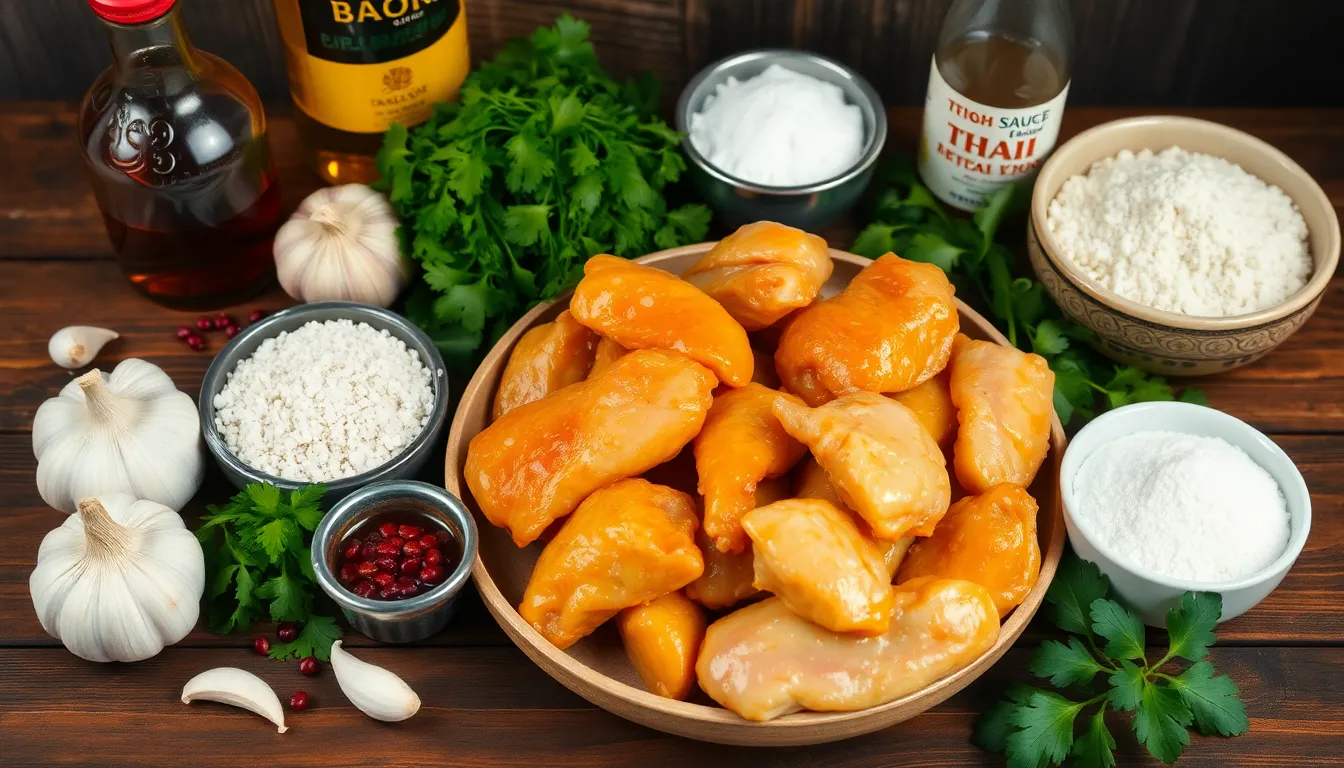
Creating authentic Gai Tod requires exact ingredients that contribute to its distinctive flavor profile and crispy texture. Gather these components before you begin cooking to ensure a smooth preparation process.
For the Marinade
- Bone-in skin-on chicken pieces (preferably thighs, drumsticks, or wings)
- 4-5 fresh garlic cloves, minced or bruised
- 2-3 cilantro roots or stems, finely chopped
- 1 tablespoon white or black peppercorns, freshly ground
- 2 tablespoons soy sauce (Thai brands like Healthy Boy work best)
- 1 tablespoon fish sauce
- 1 teaspoon sugar
- 1 teaspoon ground coriander seeds (optional, common in southern Thai versions)
- ½ teaspoon ground cumin (optional)
- ¼ cup water to help distribute marinade evenly
For the Coating
- 1 cup rice flour (the key to achieving that signature Thai crispiness)
- 2 tablespoons tapioca starch or wheat flour (optional for texture variation)
- ½ cup cold soda water (creates airiness in the batter)
- 1 teaspoon chicken bouillon powder (adds depth of flavor)
- 4-5 ice cubes (keeps the batter cool for maximum crispiness)
- Vegetable oil for deep frying (enough to submerge chicken pieces)
For the Dipping Sauce
- 2 tablespoons sugar
- 1 tablespoon ground toasted rice (provides distinctive nutty flavor)
- 2 teaspoons tamarind paste
- 1 tablespoon fish sauce
- 1-2 teaspoons chili flakes (adjust to your heat preference)
- Fresh cilantro and sliced spring onions for garnish
- Crispy fried shallots for garnish and added texture
- Sticky rice for serving (traditional accompaniment)
Essential Equipment
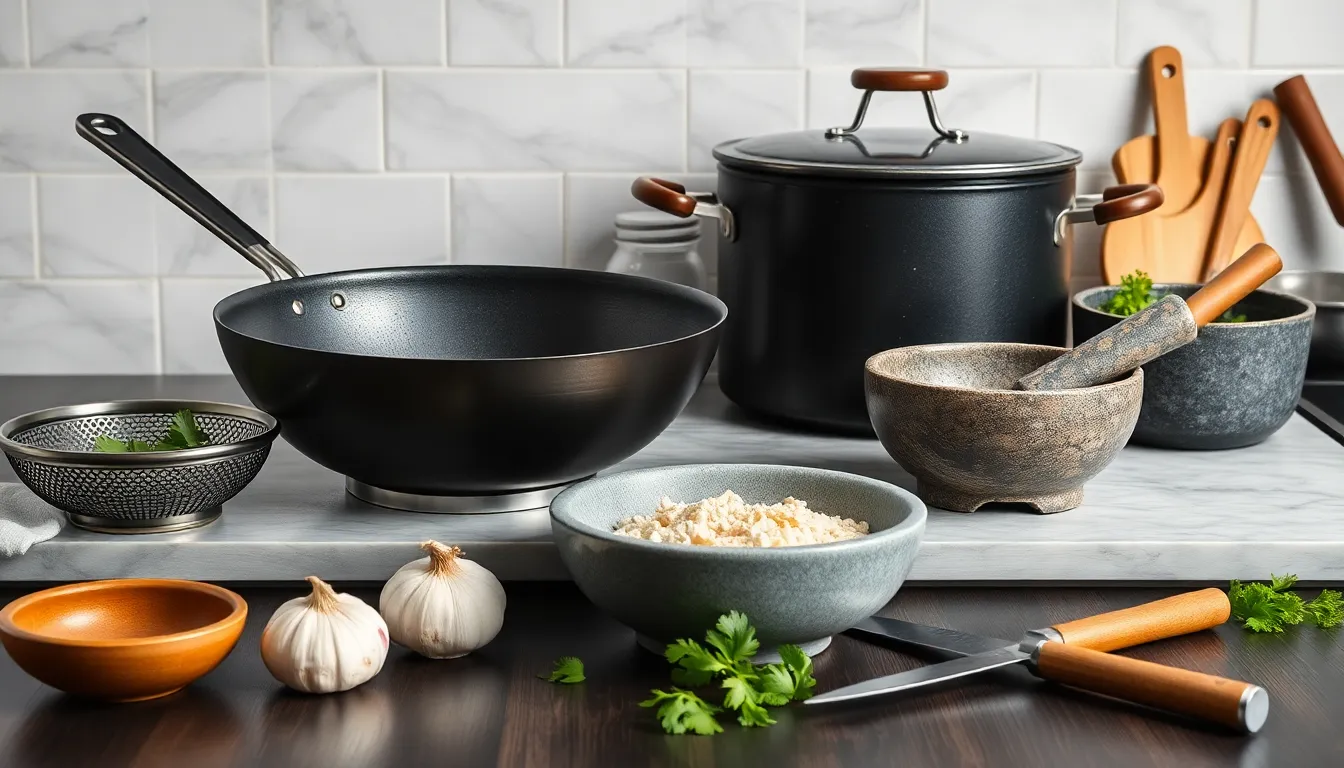
Preparing authentic Thai fried chicken (Gai Tod) requires several specialized tools to achieve that signature crispy exterior while maintaining a juicy interior. Equipping your kitchen with these essentials will help you recreate this iconic dish with restaurant-quality results.
A carbon-steel wok stands as the most important piece of equipment for Thai fried chicken. Its unique shape distributes heat evenly throughout the cooking surface, making it ideal for deep-frying chicken pieces to golden perfection. Opt for a flat-bottom wok with a long handle for better stability and easier handling during the frying process.
Don’t worry if you lack a traditional wok. A Dutch oven or large deep skillet serves as an excellent alternative for maintaining consistent oil temperature—a crucial factor in achieving that characteristic crispiness without sogginess.
The granite mortar and pestle plays an indispensable role in Thai cooking, particularly for Gai Tod. This tool allows you to pound garlic, cilantro roots, and peppercorns into a fine paste, releasing essential oils that infuse your marinade with authentic Thai flavors impossible to achieve with electric grinders.
You’ll also need a skimmer strainer to safely remove chicken pieces from hot oil while allowing excess oil to drain back into the cooking vessel. This tool helps prevent burns while ensuring your finished chicken isn’t overly greasy.
A quality sharp knife (preferably a Santoku or similar style) proves essential for properly portioning chicken into serving pieces like thighs, drumsticks, and wings. Clean cuts help ensure even cooking throughout each piece.
Additional helpful utensils include a fish turner for flipping chicken pieces during frying and a citrus press if your recipe incorporates lime juice in the marinade or accompanying dipping sauce.
With these essential tools at your disposal, you’ll be well-equipped to create authentic Thai fried chicken with the proper texture and complex flavors that make this dish a standout in Thai cuisine.
How to Make Thai Fried Chicken

Creating authentic Thai fried chicken (Gai Tod) at home requires attention to detail and proper technique. Follow these steps to achieve that perfect balance of crispy exterior and juicy interior that makes this dish so irresistible.
Preparing the Chicken
Select bone-in skin-on chicken pieces like thighs, drumsticks, and wings for optimal flavor and moisture retention. Make two small incisions in the thickest part of each chicken piece to allow the marinade to penetrate deeply into the meat. Pat the chicken dry with paper towels before applying the marinade to ensure proper absorption of flavors. Bringing the chicken to room temperature for about 30 minutes before marinating will help the seasoning distribute more evenly throughout the meat.
Marinating Process
Create a flavorful marinade by pounding garlic, cilantro roots (or stems), white and black peppercorns, and sugar together until finely ground. Add soy sauce, fish sauce, oyster sauce, and a pinch of chicken bouillon powder to the ground mixture, stirring until well combined. Coat the chicken pieces thoroughly in this aromatic blend, making sure to rub the marinade into the incisions you made earlier. Place the chicken in a covered container and refrigerate for at least 4 hours, though overnight marination yields the best results. Remove the marinated chicken from the refrigerator about 30 minutes before frying to allow it to reach room temperature for more even cooking.
Coating the Chicken
Unlike Western-style fried chicken with thick batters, Thai fried chicken uses a lighter coating that creates a delicate, crispy crust. Mix rice flour (or a combination of rice flour and gogi tempura flour) with cold water or soda water and a small amount of baking soda for leavening. The consistency should be relatively thin but able to lightly coat the back of a spoon. Dip each piece of marinated chicken directly into this batter without rinsing off the marinade first. Let excess batter drip off before frying to prevent excessive oil splatter and ensure a light, crispy coating.
Frying Techniques
Pour about 2 inches of vegetable oil into a wok or deep pot and heat to 375°F (190°C). Once the oil reaches temperature, reduce the heat to maintain around 300°F (150°C) for proper frying. Carefully lower the battered chicken pieces into the hot oil, working in small batches to avoid overcrowding which would lower the oil temperature. Turn the chicken frequently using tongs or a spider strainer to ensure even browning on all sides. Fry dark meat pieces until they reach an internal temperature of 175°F (79°C) and white meat to 155°F (68°C) for perfect doneness. Transfer the fried chicken to a wire rack set over a baking sheet, allowing it to rest for 5-10 minutes before serving. This resting period completes the cooking process and allows the juices to redistribute throughout the meat for maximum flavor and tenderness.
Tips for Perfectly Crispy Thai Fried Chicken
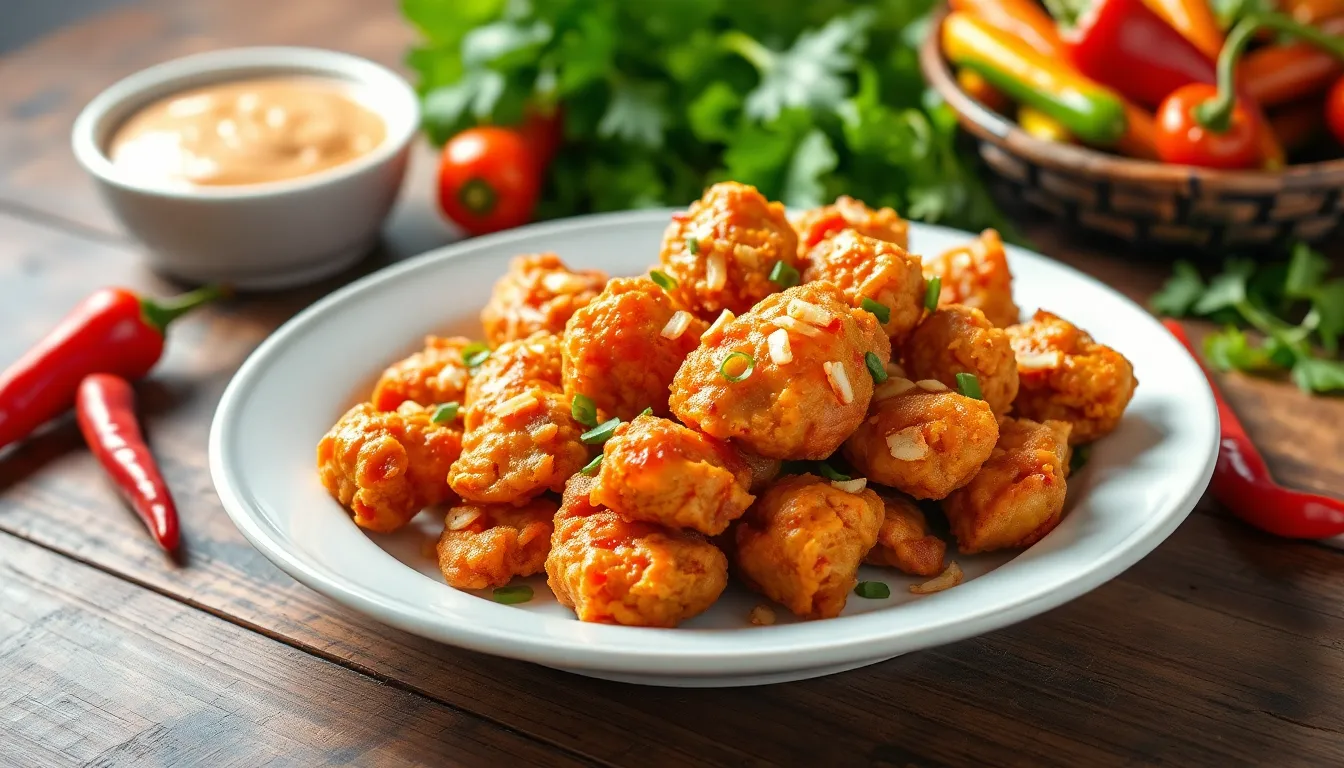
Achieving that perfect crispy exterior while maintaining juicy meat inside is the hallmark of authentic Thai fried chicken. Follow these expert tips to elevate your Gai Tod to restaurant quality:
Marinate Thoroughly
Allow your chicken to marinate for at least 4 hours preferably overnight. This extended time ensures the flavors of garlic white peppercorns cilantro stems and fish sauce penetrate deeply into the meat. Score the chicken pieces before marinating to create channels for the flavors to seep in maximizing both tenderness and taste.
Choose the Right Flour
Rice flour creates that distinctively light crispy crust that sets Thai fried chicken apart. For even better results mix rice flour with tempura flour which contains baking powder and cornflour. This combination delivers an exceptionally crunchy texture that stays crisp longer than wheat flour batters.
Control Oil Temperature
Master the double-frying technique by starting with oil at 375°F (190°C) for the initial fry which creates the crisp exterior. Then lower the temperature to about 300°F (150°C) for the second fry allowing the chicken to cook through without burning. This temperature control is crucial for perfect results every time.
Avoid Overcrowding
Fry chicken in small batches giving each piece plenty of room. Overcrowding causes the oil temperature to drop significantly resulting in soggy rather than crispy chicken. Patience during this step pays off with superior crispiness.
Rest Before Serving
Let your fried chicken rest for 5-10 minutes after frying. This resting period allows the crust to set properly and helps the juices redistribute throughout the meat. The internal temperature should reach approximately 175°F (79°C) for dark meat and 155°F (68°C) for breast meat to ensure food safety without drying out.
Perfect Your Crispy Shallots
For the traditional crispy shallot garnish slice shallots thinly and press between paper towels to remove excess moisture. Fry them slowly over low heat stirring occasionally until they reach a golden brown color. These crispy shallots add another textural dimension that complements the crunchy chicken beautifully.
Maintain Dryness
Ensure your chicken pieces are patted completely dry before coating. Any excess moisture will create steam during frying interfering with the crisp texture formation. For extra insurance you can refrigerate the coated chicken uncovered for 15 minutes before frying to eliminate surface moisture.
Serving Suggestions
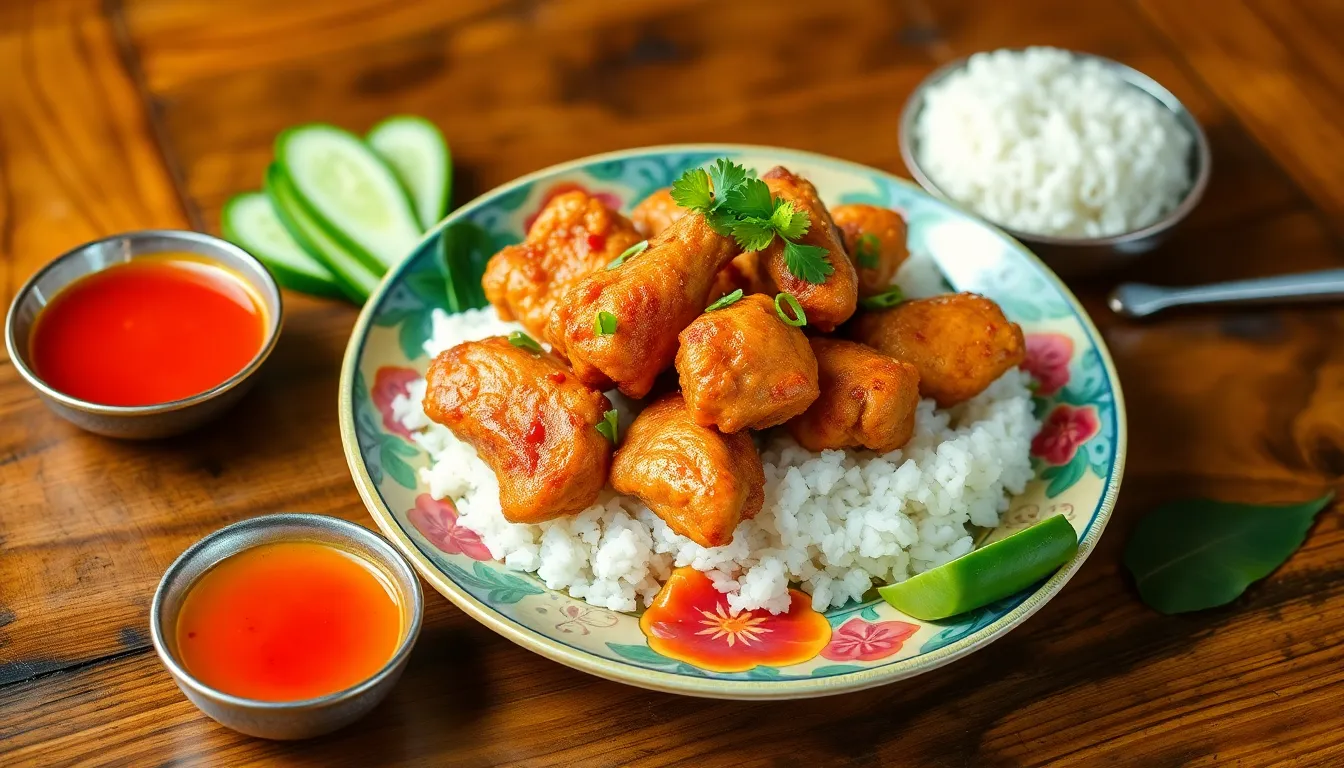
Thai fried chicken (Gai Tod) truly shines when paired with complementary dishes that enhance its bold flavors and crispy texture. Sticky rice serves as the traditional accompaniment to this dish creating a perfect textural contrast between the crunchy chicken and chewy rice grains. This classic pairing forms the foundation of an authentic Thai fried chicken experience allowing the rice to soak up the savory juices.
Sweet chili sauce provides an ideal dipping option that balances the savory notes of the chicken with subtle sweetness and mild heat. The vibrant sauce adds a glossy coating to each bite making the flavor profile more complex and satisfying. For a complete meal presentation add fresh cucumber slices alongside your Gai Tod to cleanse the palate between bites of the rich fried chicken.
Many Thai families and street vendors serve Gai Tod with som tum (papaya salad) to create a balanced meal experience. The tangy spicy flavors of som tum cut through the richness of the fried chicken while adding freshness to your plate. This combination represents a classic street food pairing throughout Thailand offering contrasting yet complementary tastes.
Gai Tod functions beautifully in various dining contexts from casual snacks to elaborate meals. Serve it as:
- The centerpiece of a family-style dinner with several side dishes
- A protein option for outdoor gatherings and barbecues
- A shareable appetizer with dipping sauces
- Part of a larger Thai food spread alongside noodle dishes and curries
A garnish of fresh herbs such as cilantro or Thai basil adds brightness and aroma to your plated Gai Tod. The herbaceous notes provide a final layer of flavor that enhances the aromatic qualities of the marinade. Crispy fried shallots sprinkled over the chicken just before serving add extra crunch and a subtle sweetness that complements the savory chicken beautifully.
Variations of Thai Fried Chicken
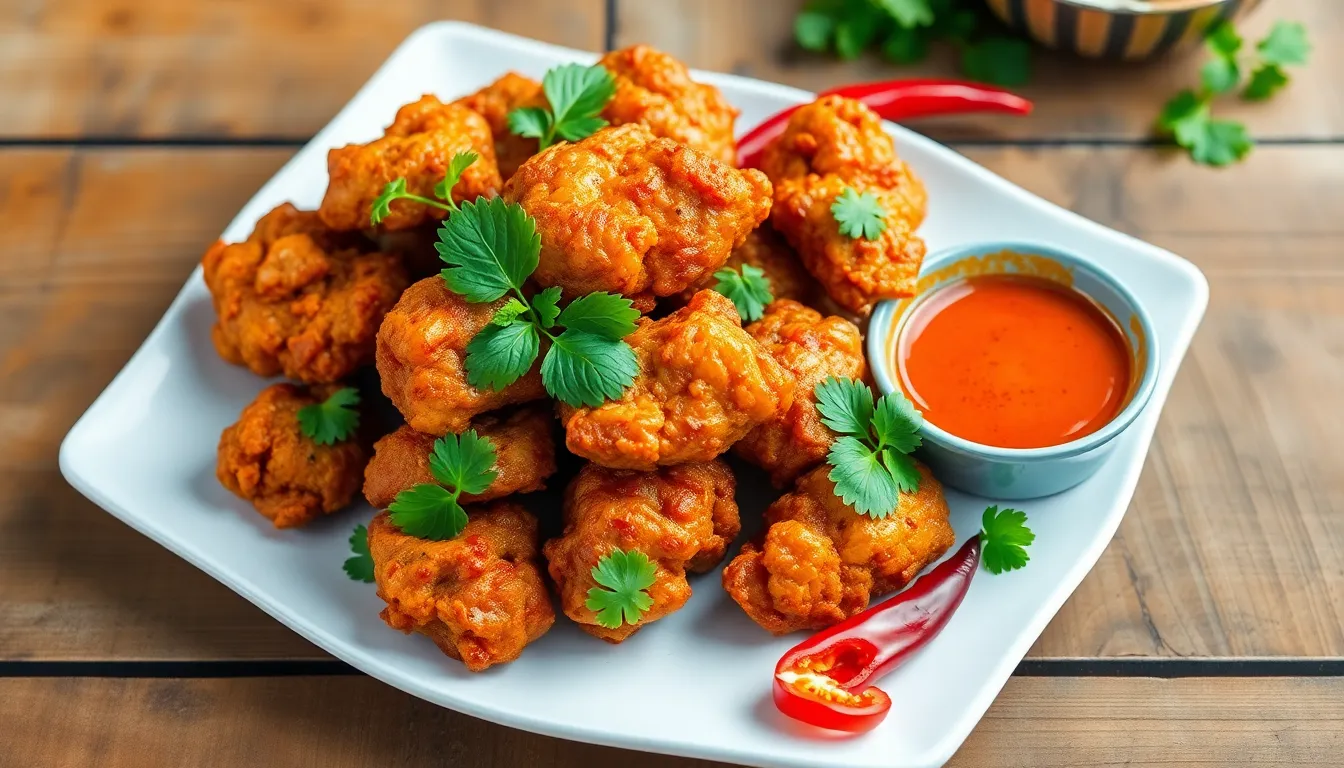
Thai fried chicken offers many regional and flavor variations across Thailand that showcase the diverse culinary traditions of the country. Each version maintains the signature crispy exterior while introducing unique flavor profiles that make this dish endlessly adaptable.
Spicy Version
The spicy variation of Thai fried chicken kicks the heat level up several notches for those who crave intensity in every bite. You can incorporate spiciness directly into the marinade by adding fresh Thai bird’s eye chilies or dried chili flakes to the standard blend of garlic, cilantro roots and peppercorns. Many Thai families serve their crispy chicken alongside Nam Jim Jeaw – a tangy dipping sauce made with chili flakes, tamarind paste, fish sauce, toasted rice powder and fresh herbs like cilantro and spring onions. This sauce perfectly complements the richness of the fried chicken with its complex flavor profile balancing heat, acidity, saltiness and umami. For an even more pronounced spicy kick, try marinating your chicken overnight to allow the chili flavors to fully penetrate the meat before frying.
Herb-Infused Option
The herb-infused variation celebrates Thailand’s abundance of fresh aromatics by amplifying the herbal notes in the marinade. Traditional Thai herbs like lemongrass, galangal, kaffir lime leaves and Thai basil create a fragrant foundation that differentiates this style from other fried chicken variations. You can crush these herbs in a mortar and pestle along with garlic, cilantro roots and peppercorns to release their essential oils before mixing with fish sauce and soy sauce for the marinade. The Hat Yai style from southern Thailand exemplifies this herb-forward approach by incorporating shallots both in the marinade and as a crispy topping. These fried shallots provide a sweet aromatic crunch that enhances the overall flavor profile. Fresh herbs also make an excellent garnish – try sprinkling Thai basil leaves and cilantro over your finished chicken for a burst of color and an additional layer of herbaceous flavor that balances the richness of the fried exterior.
Make-Ahead and Storage Instructions
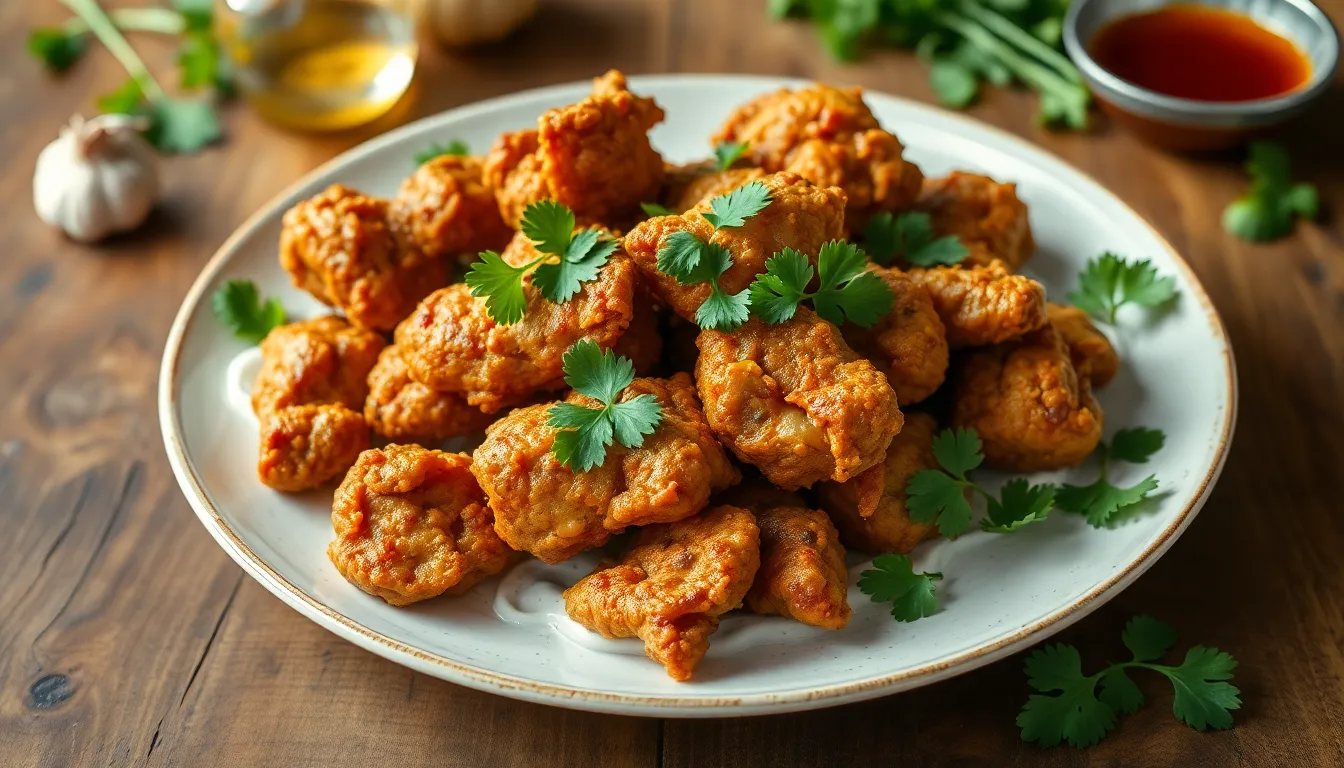
Prepare in Advance
You can easily prepare Thai fried chicken ahead of time by marinating the chicken pieces at least 4 hours before cooking. For maximum flavor development, marinate your chicken overnight in the refrigerator. This extended marination allows the aromatic blend of peppercorns, garlic, cilantro stems, and sauces to fully penetrate the meat, resulting in more flavorful Gai Tod.
Proper Storage
After cooking your Thai fried chicken, consume it the same day for optimal crispiness. If you have leftovers, allow them to cool completely to room temperature before transferring to an airtight container. Refrigerate promptly where the chicken will remain good for up to 3 days.
Maintaining Crispiness
To maintain the signature crispiness of Hat Yai fried chicken when reheating, avoid using the microwave which can make the coating soggy. Instead, reheat in a preheated oven at 350°F for about 10-15 minutes until warmed through. This method helps preserve the crispy exterior while ensuring the chicken heats evenly.
Freezing Options
For longer storage, you can freeze marinated but uncooked chicken pieces. Place them in a freezer-safe container or bag, separating layers with parchment paper to prevent sticking. When ready to cook, thaw completely in the refrigerator before proceeding with the coating and frying steps. Always ensure the chicken reaches an internal temperature of 165°F (74°C) when cooking from frozen or refrigerated.
| Storage Method | Duration | Temperature |
|---|---|---|
| Marinated (refrigerated) | 2-24 hours | 40°F (4°C) |
| Cooked (refrigerated) | Up to 3 days | 40°F (4°C) |
| Uncooked (frozen) | 1-2 months | 0°F (-18°C) |
| Internal cooking temperature | N/A | 165°F (74°C) for all chicken 175°F (79°C) for dark meat |
The Perfect Dipping Sauce
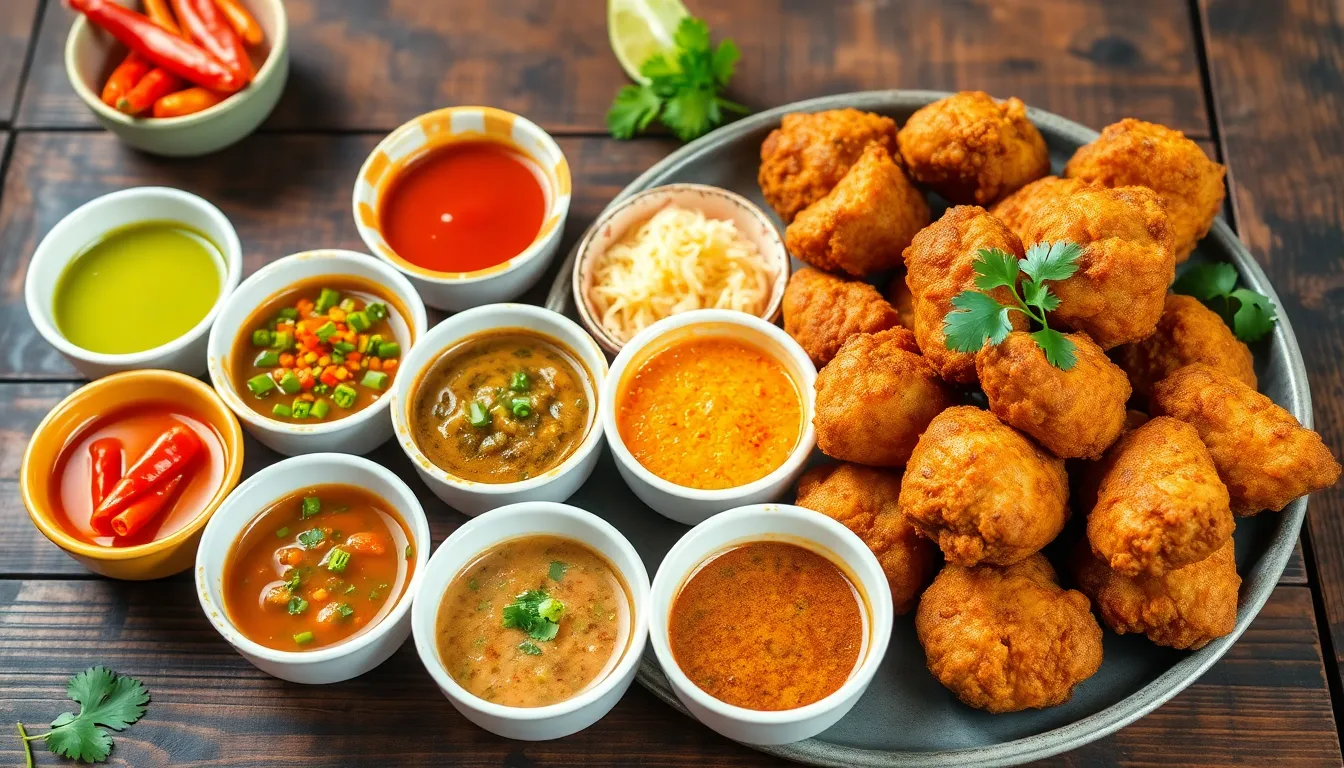
No Thai fried chicken experience is complete without an authentic dipping sauce that balances the perfect harmony of flavors. Traditional Thai dipping sauces combine sweet sour salty and spicy elements to complement the savory crunch of Gai Tod. These vibrant condiments cut through the richness of the fried chicken while improving its aromatic qualities.
Thai dipping sauces typically feature fish sauce as the umami foundation paired with fresh lime juice for brightness. Red and green chilies provide customizable heat while palm sugar adds caramel-like sweetness that balances the acidic components. Fresh herbs like cilantro or culantro contribute aromatic complexity essential to authentic Thai flavor profiles.
Classic Thai Sweet Chili Sauce
- 3 tablespoons fish sauce
- 2 tablespoons fresh lime juice
- 1-3 Thai bird’s eye chilies minced (adjust to taste)
- 2 tablespoons palm sugar or brown sugar
- 1 tablespoon minced shallots
- 1 tablespoon chopped cilantro
- 1 teaspoon water (to adjust consistency)
Start by combining fish sauce and lime juice in a small bowl. Stir in minced chilies and shallots thoroughly distributing them throughout the liquid. Dissolve palm sugar into the mixture ensuring no granules remain. Add chopped cilantro just before serving to maintain freshness and bright color. This sauce can be prepared up to 24 hours in advance allowing flavors to meld in the refrigerator.
Nam Jim Jaew (Northeastern Thai Dipping Sauce)
- 2 tablespoons fish sauce
- 1 tablespoon lime juice
- 1 tablespoon tamarind paste
- 1 tablespoon palm sugar
- 1 teaspoon toasted rice powder
- 1-2 teaspoons chili flakes
- 1 tablespoon finely chopped shallots
- 1 tablespoon chopped cilantro
Warm tamarind paste palm sugar fish sauce and a splash of water over medium heat until the sugar completely dissolves. The mixture should slightly thicken but remain pourable. Remove from heat and allow to cool before stirring in chili flakes shallots and toasted rice powder. This sauce offers a smoky tangy profile that pairs exceptionally well with the crispy chicken. Sprinkle chopped cilantro over the sauce just before serving for a fresh herbal aroma.
Both sauce variations complement Thai fried chicken perfectly by cutting through the richness with acidity while adding layers of flavor. The ideal dipping sauce should awaken your palate with each bite making you crave another piece of that golden crispy Gai Tod. Serve these sauces in small individual bowls allowing your guests to adjust the amount according to their preference.
Conclusion
Thai fried chicken represents the perfect harmony of texture and flavor that’s distinctly different from other global versions. The magic lies in its aromatic marinade and double-frying technique that delivers that signature crunch while keeping the meat incredibly juicy.
Whether you’re making the classic Gai Tod or exploring regional variations try not to skip the essential dipping sauces that balance the dish perfectly. With proper tools and techniques you’ll master this Thai street food favorite right in your kitchen.
Once you experience the fragrant crispiness of authentic Gai Tod paired with sticky rice and fresh herbs you’ll understand why this dish has earned its place as one of Thailand’s most beloved culinary treasures.
Frequently Asked Questions
What is Thai Fried Chicken (Gai Tod)?
Gai Tod is authentic Thai fried chicken characterized by its crispy exterior and juicy interior. It features unique flavors from lemongrass, garlic, and traditional Thai spices that distinguish it from other fried chicken varieties. The dish typically uses a lighter rice flour coating and employs a double-frying technique to achieve its signature texture.
What makes Thai fried chicken different from other varieties?
Thai fried chicken stands out with its complex marinade of aromatic herbs and spices native to Southeast Asia. Key ingredients like lemongrass, fresh garlic, coriander roots, and fish sauce create deep flavor layers. It uses a lighter rice flour coating rather than thick batters, and the double-frying method ensures exceptional crispiness while maintaining juiciness inside.
What are the essential ingredients for Gai Tod?
Essential ingredients include bone-in skin-on chicken pieces, garlic, cilantro roots, peppercorns, soy sauce, fish sauce, and sugar for the marinade. The coating requires rice flour, tapioca starch, and cold soda water. For serving, prepare a dipping sauce with sugar, toasted rice, tamarind paste, fish sauce, and chili flakes, garnished with fresh cilantro and fried shallots.
What equipment do I need to make authentic Thai fried chicken?
A carbon-steel wok is ideal for even heat distribution during frying, though a Dutch oven or deep skillet works too. A granite mortar and pestle helps create a fine paste for the marinade. Other helpful tools include a skimmer strainer for removing chicken from hot oil, a sharp knife for portioning, and a fish turner for flipping the chicken.
How long should I marinate the chicken?
Marinate the chicken for at least four hours, though overnight is preferable for maximum flavor penetration. Make incisions in the chicken pieces before marinating to allow the flavorful blend of garlic, cilantro roots, peppercorns, and sauces to penetrate deeply into the meat.
What’s the secret to getting crispy Thai fried chicken?
The secret lies in thorough marination, using a combination of rice flour and tempura flour, and controlling oil temperature during double-frying. Avoid overcrowding the pan, ensure chicken pieces are dry before coating, and allow the chicken to rest after frying so juices redistribute. Proper oil temperature (350-375°F) is crucial for crispiness.
What should I serve with Gai Tod?
Gai Tod pairs beautifully with sticky rice, sweet chili sauce, and fresh cucumber slices. A classic pairing is with som tum (papaya salad) for a balanced meal. Garnish with fresh herbs like cilantro or Thai basil and crispy fried shallots for added flavor and texture. This versatile dish works well for family dinners or outdoor gatherings.
Are there different regional variations of Thai fried chicken?
Yes, regional variations include a spicy version with Thai bird’s eye chilies served with Nam Jim Jeaw dipping sauce, and an herb-infused version using lemongrass, galangal, and kaffir lime leaves. Hat Yai style adds fried shallots for sweet crunch. These variations showcase Thailand’s diverse culinary traditions and allow customization to different taste preferences.
How do I store and reheat leftover Gai Tod?
Consume Gai Tod the same day for optimal crispiness. Store leftovers in an airtight container in the refrigerator for up to three days. Reheat in a preheated oven, not microwave, to maintain crispiness. Uncooked marinated chicken can be frozen for 1-2 months. Thaw completely before cooking for food safety.
What dipping sauces go best with Thai fried chicken?
Traditional Thai dipping sauces that balance sweet, sour, salty, and spicy elements complement Gai Tod perfectly. Two excellent options are classic Thai sweet chili sauce and Nam Jim Jaew (a Northeastern Thai sauce). These sauces cut through the richness while adding flavor layers. Serve in small bowls so guests can customize their dipping preferences.
